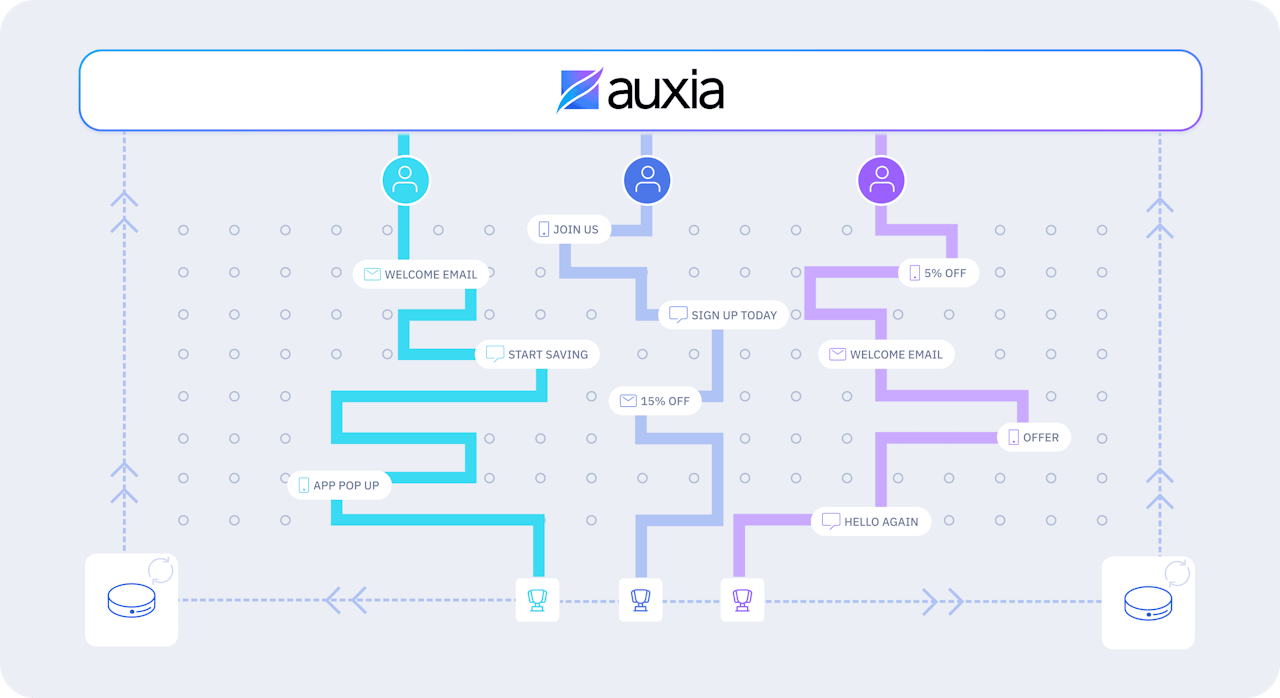What is Agentic Journey Orchestration?
![]() Cole StuartJun 1, 20257 min
Cole StuartJun 1, 20257 min

Unlocking the Future of Marketing: Agentic Journey Orchestration
A new layer of the marketing stack is reshaping how organizations operate and engage with their customers – Agentic Journey Orchestration. Also referred to as AI Decisioning, this article will provide an overview of Agentic Journey Orchestration, define how this approach differs from traditional, deterministic approaches to creating customer journeys, and touch on a few example use cases.
So what is Agentic Journey Orchestration?
Agentic Journey Orchestration is how marketing and product teams leverage traditional machine learning methods (ML) and recent advancements in LLMs to make real-time, personalized choices about how to interact with each individual customer in a highly personalized way.
Most technology solutions today allow teams to send messages to their customers across channels by manually creating a cadence that follows rigid, pre-set rules for generic customer segments. Alternatively, Agentic Journey Orchestration constantly analyzes live data, behavioral signals, and historical information to determine the optimal touchpoint for each specific customer at that precise moment to drive the downstream behavior a business cares about (e.g. conversion, retention, etc). Whereas many solutions previously promised to deliver the “next best action”, AI-based systems can predict the a combination of the next best action, content, product, timing, frequency, and incentive to drive the desired goal.
AI vs. Traditional, Rules-Based Approaches
So how does this differ from how marketing and product teams orchestrated their product experiences and campaigns previously?
Before AI
Traditional, Rules-Based Decisioning is built on predefined rules and conditional logic, often requiring human adjustments. Picture a marketing team organizing a welcome email campaign. These systems require manual updates to modify logic or enhance performance, making them less adaptable to rapidly changing environments.
Companies building customer journeys often faced a number of challenges:
Underutilized Data: A vast majority (over 68%) of rich customer data sits idle, unused for personalization, largely because most companies can’t affort the specialized data science and engineering resources needed to activate it.
Manual & Inefficient Processes: Traditional rules-based journey creation is highly manual, cumbersome, and time-consuming, hindering agility and responsiveness.
Scalability of Human Decision-Making: As enterprises grow, the limitations of human decision-making become apparent, making it increasingly difficult to coordinate efforts across teams and effectively test the numerous hypotheses required for truly intelligent, one-to-one customer experiences.
After AI
Agentic Journey Orchestration leverages sophisticated artificial intelligence techniques, primarily classical machine learning (ML) and large language models (LLMs), to make autonomous or semi-autonomous business choices, all laddering up to a company’s high level business objective.
The ultimate goal is to deliver hyper-personalized, 1-1 experiences for each individual customer.
Here’s how it works:
Agentic systems leverage all of your 1P data to make more impactful decisions for each customer. These systems have robust infrastructure that automates the complex data transformation work required to put ML models in production across your product or marketing experiences. For a typical team, creating this infrastructure typically requires several months of work from a well-staffed data science and engineering team.
Teams simply define their goals, guardrails, and surfaces to engage their customers with across web / mobile product experiences or across any lifecycle channel (e.g. email, SMS, etc) of their choosing. What’s great about AI-based systems is that teams can create hundreds of variations of content for the models to choose from, as opposed to 4-5 with a typical A/B test.
AI decides the optimal touchpoint and sequence for each customer and continuously optimizes the experience in an automated experimentation loop, analyzing vast and diverse datasets to inform and optimize decisions in real-time.
The main fundamental difference is that the experience with AI is incredibly tailored to each individual based on their data and previous interactions, but also extremely dynamic and adaptive. It continuously learns and refines strategies based on feedback and new data, allowing businesses to proactively respond to shifts in customer behavior. It can handle highly complex and unstructured data, making it uniquely suited for predicting intricate trends and behaviors that elude traditional rule-based systems.
The future of automated decision-making is a synergistic model where traditional enterprise marketing and product teams provides essential hypotheses, goals, guardrails, consistency, and governance, while AI Decisioning offers dynamic adaptability, personalization, and scale.
Example Use Cases
The combined power of AI Decisioning and Agentic Journey Orchestration is driving measurable impact across diverse industries:
Retail - Drive 1st to 2nd Purchase: AI personalizes the specific product category, content, and format to drive a second purchase by analyzing purchasing history, in-session browsing behavior, and user preferences.
Consumer SaaS - Improving activation and retention: Nudge your customers to adopt and frequently engage with features that causally improve retention and are specifically useful for their distinct needs
E-Commerce - Win-back campaigns: AI personalizes the right message, timing, channel, and incentive to bring a customer back by automatically utilizing their past behavior, preferences, and interests.
Fintech / Banking - Activation, upsell / cross sell, and referrals: Identify and serve the optimal touchpoint to drive a user to complete onboarding, understand what products are right for them, and automatically surface the right incentive amount to encourage them to refer their friends.
Hospitality - Loyalty & Engagement: Personalize your customer's loyalty rewards and experience based on past bookings, preferences, and spending habits.